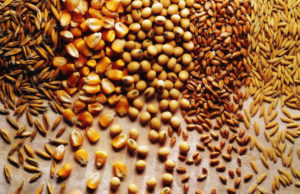 Grain futures rose on Wednesday with soybeans slightly advancing, while corn and wheat posted moderate gains on mostly unfavorable weather conditions in the U.S. and South America. Rising U.S. exports also supported prices.
Grain futures rose on Wednesday with soybeans slightly advancing, while corn and wheat posted moderate gains on mostly unfavorable weather conditions in the U.S. and South America. Rising U.S. exports also supported prices.
On the Chicago Board of Trade, soybeans futures for delivery in November rose by 0.21% to $13.0488 per bushel at 9:42 GMT. Prices held in range between days high and low of $13.0513 and $12.9688 a bushel respectively. The oilseed fell by 0.1% on Tuesday but extended its weekly advance to 1.1% on Wednesday.
Soybeans drew support as unfavorable weather in the U.S. and parts of South America continued to delay field work. DTN reported on October 22 that light snow and rain in the Midwest will disrupt the harvest and slow the drying process. Cold but dry weather later in the week will be more favorable for the harvest but wet and stormy conditions may develop in the next six to ten days that would impair field work, the agency said.
In Brazil, heavy rains may affect the Rio Grande do Sul and Parana states in the next five days, which would slow down the wheat harvest and planting of corn and soybeans.
Gains were however limited after the U.S. Department of Agriculture reported on Monday that U.S. farmers accelerated the harvest and more than 50% of the crop was categorized as good-excellent. As of October 20, 63% of the crop was reaped, compared to the five-year average of 69% and last year’s 79% during the comparable week. As for the crop condition, 14% of the plants were categorized as “Very poor” and “Poor”, while 29% fell in the “Fair” category. As for the premium grade, 57% of the crop was rated good-excellent.
Also pressuring the market, Brazil’s soybean planting progress was estimated at 18% finished, near the five-year average. The USDA predicted that the South American country may harvest an all-time high of 88 million tons of soybeans, while U.S. output may surge to 85.7 million tons. The government agency will release its next WASDE report (World Agricultural Supply and Demand Estimates) on November 8 after the latest was canceled on October 11 due to the lack of government funding.
Elsewhere on the market, corn futures for settlement in December rose by 0.75% to $4.4188 per bushel at 9:33 GMT. Prices held in range between days high and low of $4.4213 and $4.3763 per bushel respectively. The grain fell by nearly 1.5% on Tuesday but rose back to positive weekly territory on Wednesday.
The USDA said in its crop progress report that the corn harvest fell well behind last year’s pace. As of October 20, 39% of the crop was reaped compared to the five-year average of 53% and 85% in the comparable week in 2012.
As for the crop condition, 14% of the harvest was rated very poor-poor, while 26% of the plants were categorized as “Fair”. As for the premium grade, 60% of the crop fell in the “Good” and “Excellent” categories.
Wheat gains as well
Wheat also advanced on Wednesday on rising U.S. exports and risk of freeze damage to crops in Argentina. Wheat for delivery in December rose by 0.91% to session high of $7.0700 per bushel at 9:39 GMT, while days low stood at $6.9975 per bushel. The grain added 0.25% on Tuesday and extended its weekly advance to 0.2%.
Wheat rose for a second day after the USDA reported that U.S. wheat exports jumped by 25% to 20.582 million tons in the week ended October 17 from a year earlier. Sterling Smith, a futures specialist at Citigroup Inc., said yesterday for Bloomberg that dryness in South America may curb output in Argentina, forcing Brazilian buyers to import, supporting world prices.
DTN reported on Tuesday that the Southern Plains will see mostly favorable conditions for planting and developing of wheat but showers in Brazil will delay the harvest. In Argentina, lows on Wednesday and Thursday are expected to turn negative, putting heading wheat at risk of freezing.
The USDA reported on Monday that as of October 20, 79% of the U.S. winter wheat crop was planted, compared to 80% a year earlier and equaling the five-year average. The agency also said that 53% of plants had emerged, 1% below the five-year average but exceeding last year’s 48% during the comparable week.
As for the crop condition, 65% of the plants were rated good-excellent, while only 4% were categorized as very poor-poor and 31% fell in the “Fair” category.





